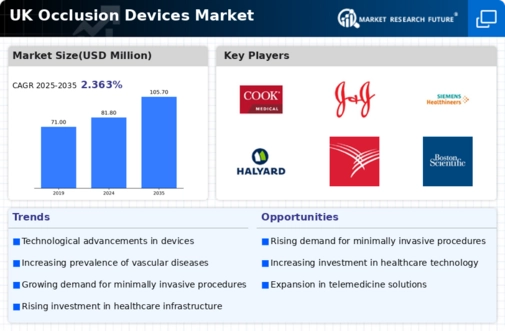Government Initiatives and Funding
Government initiatives aimed at improving healthcare infrastructure in the UK are positively impacting the occlusion devices market. Increased funding for medical research and development, along with initiatives to enhance surgical capabilities, are fostering an environment conducive to market growth. The UK government has committed to investing £20 billion in the NHS over the next five years, which is expected to facilitate the procurement of advanced medical devices, including occlusion devices. This financial support is likely to encourage healthcare providers to adopt innovative solutions, thereby expanding the market. As a result, the occlusion devices market may experience accelerated growth, with projections indicating a compound annual growth rate of 7% through 2028, driven by enhanced access to funding and resources.
Rising Incidence of Cardiovascular Diseases
The increasing prevalence of cardiovascular diseases in the UK is a primary driver for the occlusion devices market. According to recent health statistics, cardiovascular diseases account for approximately 27% of all deaths in the UK, highlighting a critical need for effective treatment options. As healthcare providers seek to address this growing concern, the demand for occlusion devices, which are essential in various surgical procedures, is likely to rise. The market is projected to expand as hospitals and clinics invest in advanced occlusion technologies to improve patient outcomes. This trend suggests that the occlusion devices market will experience significant growth, potentially reaching a valuation of £1.5 billion by 2027, driven by the urgent need for innovative solutions in cardiovascular care.
Technological Innovations in Medical Devices
Technological advancements in medical devices are transforming the landscape of the occlusion devices market. Innovations such as minimally invasive techniques and enhanced imaging technologies are improving the efficacy and safety of occlusion procedures. For instance, the introduction of bioresorbable occlusion devices has garnered attention for their potential to reduce long-term complications. The UK market is witnessing a surge in research and development activities, with companies investing heavily in creating next-generation occlusion devices. This focus on innovation is expected to propel the market forward, with an anticipated growth rate of 8% annually over the next five years. As healthcare providers adopt these advanced technologies, the occlusion devices market is likely to benefit from increased adoption rates and improved patient satisfaction.
Aging Population and Increased Surgical Procedures
The aging population in the UK is contributing significantly to the growth of the occlusion devices market. As individuals age, the likelihood of developing conditions that require surgical intervention, such as aneurysms and vascular diseases, increases. The Office for National Statistics projects that by 2030, the number of people aged 65 and over will rise to 23% of the total population. This demographic shift is expected to drive demand for occlusion devices, as healthcare systems adapt to the needs of older patients. Furthermore, the increase in elective surgical procedures among this age group is likely to enhance market growth. The occlusion devices market is poised to expand, with estimates suggesting a potential market size of £1.2 billion by 2026, reflecting the growing need for effective surgical solutions.
Growing Awareness and Education on Vascular Health
There is a notable increase in awareness and education regarding vascular health among the UK population, which is influencing the occlusion devices market. Public health campaigns and educational programs are informing individuals about the risks associated with vascular diseases and the importance of early intervention. This heightened awareness is likely to lead to an increase in diagnostic procedures and subsequent surgical interventions, thereby driving demand for occlusion devices. Healthcare professionals are also becoming more adept at recognizing conditions that necessitate the use of these devices, further contributing to market growth. The occlusion devices market is expected to benefit from this trend, with estimates suggesting a potential increase in market size by 10% over the next three years as awareness continues to rise.

















Leave a Comment